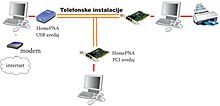HomePNA
The Home Phoneline Networking Alliance (HomePNA) is an industry association that published its second standard for computer networks with telephone cables in private households in 1999.
functionality
HomePNA establishes a home network for computer networks using simple, mostly existing telephone wiring, for example for shared Internet access. This does not restrict further use of the telephone line for making calls. There are also products that use the existing television cables for data transmission. Up to 50 network nodes ( computers ) can be connected via a PNA network . Initially, a data transfer rate of 1 Mbit per second was planned, later 10 Mbit / s, now with HomePNA 3.1 up to 320 Mbit / s. It works with a frequency range from 4 to 10 MHz. HomePNA is a widespread technology for home networks in the USA , but has hardly caught on in Europe.
Standards
The ITU standard G.989.1 (Phoneline Networking Transceivers - Foundation) defines the technical specification for the transmission of data over existing telephone lines in the home.
application
In Germany, a HomePNA variant from the manufacturers Merten (as Line 21 ) and Rutenbeck (as line21 ) is offered. This system requires a 4-core telephone cable and can provide parallel telephone and network with up to 100 Mbit / s with 30 m cable length and with 50 m with 10 Mbit / s.
In addition to being used as a home network, HomePNA variants are also used to supply residential units with the Internet. As with DOCSIS , the customer receives a cable modem, but no special multimedia cable socket is required for connection. Since the technology does not allow the bridging of large distances like DOCSIS, it is particularly suitable for smaller buildings that are accessed via FTTB . HPNA for Internet access is already widespread in Eastern Europe.
Individual evidence
- ↑ Home Networking Alliance Approves a Faster standard . The New York Times . December 2, 1999. Retrieved October 19, 2013.
- ↑ https://www.elektronik-kompendium.de/sites/net/0904201.htm
- ↑ http://www.homepna.org/about/faq/#about9
- ↑ https://www.fehrnetzt.de/netzwerk-uber-vorhandene-telefonkabel-line-21-machts-moglich
